Critical Analysis of HRM Theories and Models at HCL Technologies
VerifiedAdded on 2023/04/17
|11
|2180
|219
Report
AI Summary
This report provides a critical analysis of strategic human resource management (HRM) theories and models. It begins by comparing and contrasting two prominent HRM theories: Expectancy theory and the Job Characteristics model, highlighting their similarities and differences in motivating employees. The report then examines two HR models, the Warwick model and the Matching model, assessing their impact on business decisions. The analysis is then applied to HCL Technologies Limited, where the Job Characteristic theory and the Warwick model are selected for implementation. The report justifies the selection of the Warwick model as the most suitable for HCL Technologies, emphasizing its ability to consider both internal and external factors to achieve desired HRM outcomes and sustain organizational growth. The report concludes by summarizing the key findings and the importance of aligning HRM practices with organizational strategy.

Strategic Human Resource Management
Paraphrase This Document
Need a fresh take? Get an instant paraphrase of this document with our AI Paraphraser
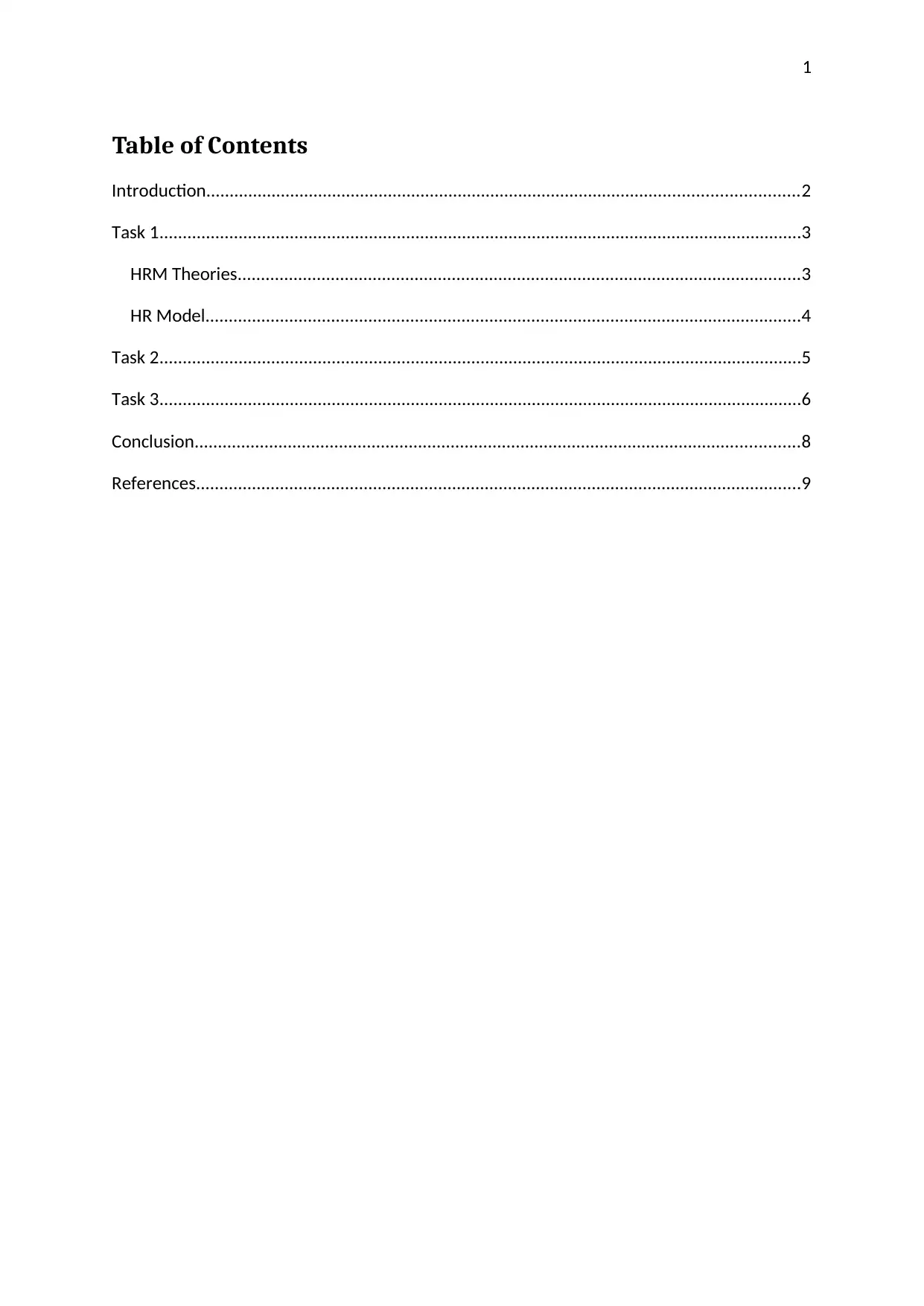
1
Table of Contents
Introduction...............................................................................................................................2
Task 1..........................................................................................................................................3
HRM Theories.........................................................................................................................3
HR Model................................................................................................................................4
Task 2..........................................................................................................................................5
Task 3..........................................................................................................................................6
Conclusion..................................................................................................................................8
References..................................................................................................................................9
Table of Contents
Introduction...............................................................................................................................2
Task 1..........................................................................................................................................3
HRM Theories.........................................................................................................................3
HR Model................................................................................................................................4
Task 2..........................................................................................................................................5
Task 3..........................................................................................................................................6
Conclusion..................................................................................................................................8
References..................................................................................................................................9
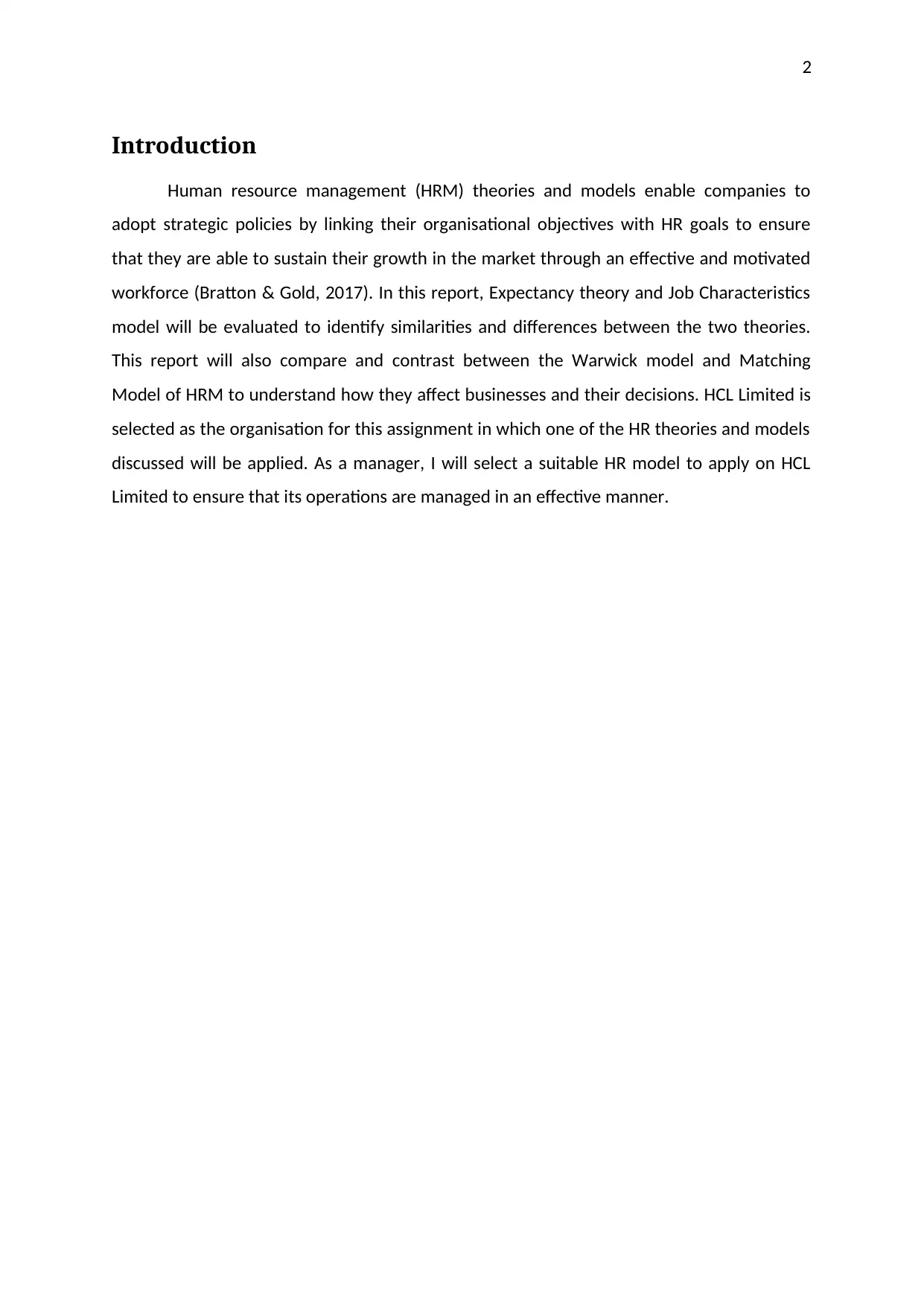
2
Introduction
Human resource management (HRM) theories and models enable companies to
adopt strategic policies by linking their organisational objectives with HR goals to ensure
that they are able to sustain their growth in the market through an effective and motivated
workforce (Bratton & Gold, 2017). In this report, Expectancy theory and Job Characteristics
model will be evaluated to identify similarities and differences between the two theories.
This report will also compare and contrast between the Warwick model and Matching
Model of HRM to understand how they affect businesses and their decisions. HCL Limited is
selected as the organisation for this assignment in which one of the HR theories and models
discussed will be applied. As a manager, I will select a suitable HR model to apply on HCL
Limited to ensure that its operations are managed in an effective manner.
Introduction
Human resource management (HRM) theories and models enable companies to
adopt strategic policies by linking their organisational objectives with HR goals to ensure
that they are able to sustain their growth in the market through an effective and motivated
workforce (Bratton & Gold, 2017). In this report, Expectancy theory and Job Characteristics
model will be evaluated to identify similarities and differences between the two theories.
This report will also compare and contrast between the Warwick model and Matching
Model of HRM to understand how they affect businesses and their decisions. HCL Limited is
selected as the organisation for this assignment in which one of the HR theories and models
discussed will be applied. As a manager, I will select a suitable HR model to apply on HCL
Limited to ensure that its operations are managed in an effective manner.
⊘ This is a preview!⊘
Do you want full access?
Subscribe today to unlock all pages.

Trusted by 1+ million students worldwide
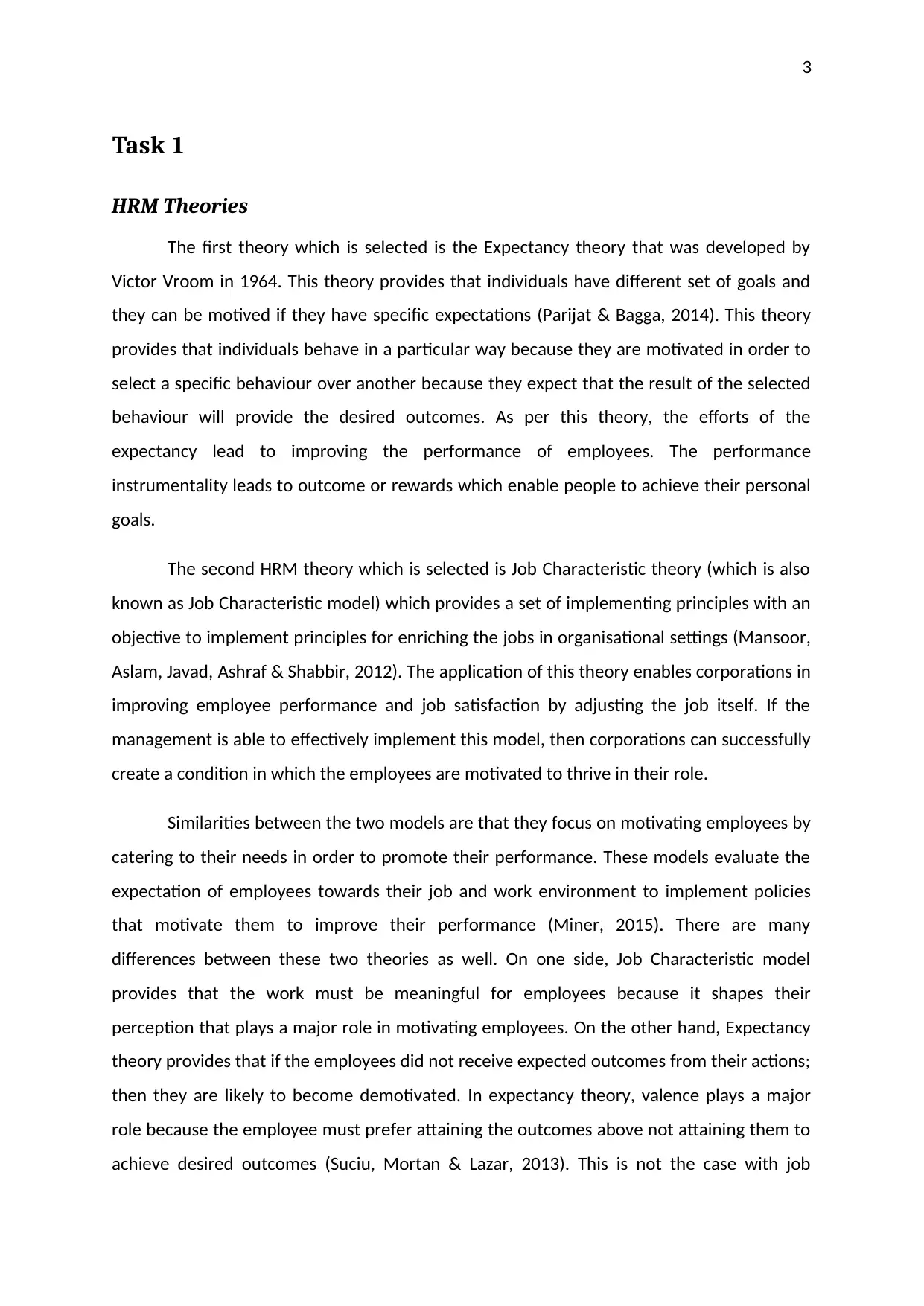
3
Task 1
HRM Theories
The first theory which is selected is the Expectancy theory that was developed by
Victor Vroom in 1964. This theory provides that individuals have different set of goals and
they can be motived if they have specific expectations (Parijat & Bagga, 2014). This theory
provides that individuals behave in a particular way because they are motivated in order to
select a specific behaviour over another because they expect that the result of the selected
behaviour will provide the desired outcomes. As per this theory, the efforts of the
expectancy lead to improving the performance of employees. The performance
instrumentality leads to outcome or rewards which enable people to achieve their personal
goals.
The second HRM theory which is selected is Job Characteristic theory (which is also
known as Job Characteristic model) which provides a set of implementing principles with an
objective to implement principles for enriching the jobs in organisational settings (Mansoor,
Aslam, Javad, Ashraf & Shabbir, 2012). The application of this theory enables corporations in
improving employee performance and job satisfaction by adjusting the job itself. If the
management is able to effectively implement this model, then corporations can successfully
create a condition in which the employees are motivated to thrive in their role.
Similarities between the two models are that they focus on motivating employees by
catering to their needs in order to promote their performance. These models evaluate the
expectation of employees towards their job and work environment to implement policies
that motivate them to improve their performance (Miner, 2015). There are many
differences between these two theories as well. On one side, Job Characteristic model
provides that the work must be meaningful for employees because it shapes their
perception that plays a major role in motivating employees. On the other hand, Expectancy
theory provides that if the employees did not receive expected outcomes from their actions;
then they are likely to become demotivated. In expectancy theory, valence plays a major
role because the employee must prefer attaining the outcomes above not attaining them to
achieve desired outcomes (Suciu, Mortan & Lazar, 2013). This is not the case with job
Task 1
HRM Theories
The first theory which is selected is the Expectancy theory that was developed by
Victor Vroom in 1964. This theory provides that individuals have different set of goals and
they can be motived if they have specific expectations (Parijat & Bagga, 2014). This theory
provides that individuals behave in a particular way because they are motivated in order to
select a specific behaviour over another because they expect that the result of the selected
behaviour will provide the desired outcomes. As per this theory, the efforts of the
expectancy lead to improving the performance of employees. The performance
instrumentality leads to outcome or rewards which enable people to achieve their personal
goals.
The second HRM theory which is selected is Job Characteristic theory (which is also
known as Job Characteristic model) which provides a set of implementing principles with an
objective to implement principles for enriching the jobs in organisational settings (Mansoor,
Aslam, Javad, Ashraf & Shabbir, 2012). The application of this theory enables corporations in
improving employee performance and job satisfaction by adjusting the job itself. If the
management is able to effectively implement this model, then corporations can successfully
create a condition in which the employees are motivated to thrive in their role.
Similarities between the two models are that they focus on motivating employees by
catering to their needs in order to promote their performance. These models evaluate the
expectation of employees towards their job and work environment to implement policies
that motivate them to improve their performance (Miner, 2015). There are many
differences between these two theories as well. On one side, Job Characteristic model
provides that the work must be meaningful for employees because it shapes their
perception that plays a major role in motivating employees. On the other hand, Expectancy
theory provides that if the employees did not receive expected outcomes from their actions;
then they are likely to become demotivated. In expectancy theory, valence plays a major
role because the employee must prefer attaining the outcomes above not attaining them to
achieve desired outcomes (Suciu, Mortan & Lazar, 2013). This is not the case with job
Paraphrase This Document
Need a fresh take? Get an instant paraphrase of this document with our AI Paraphraser
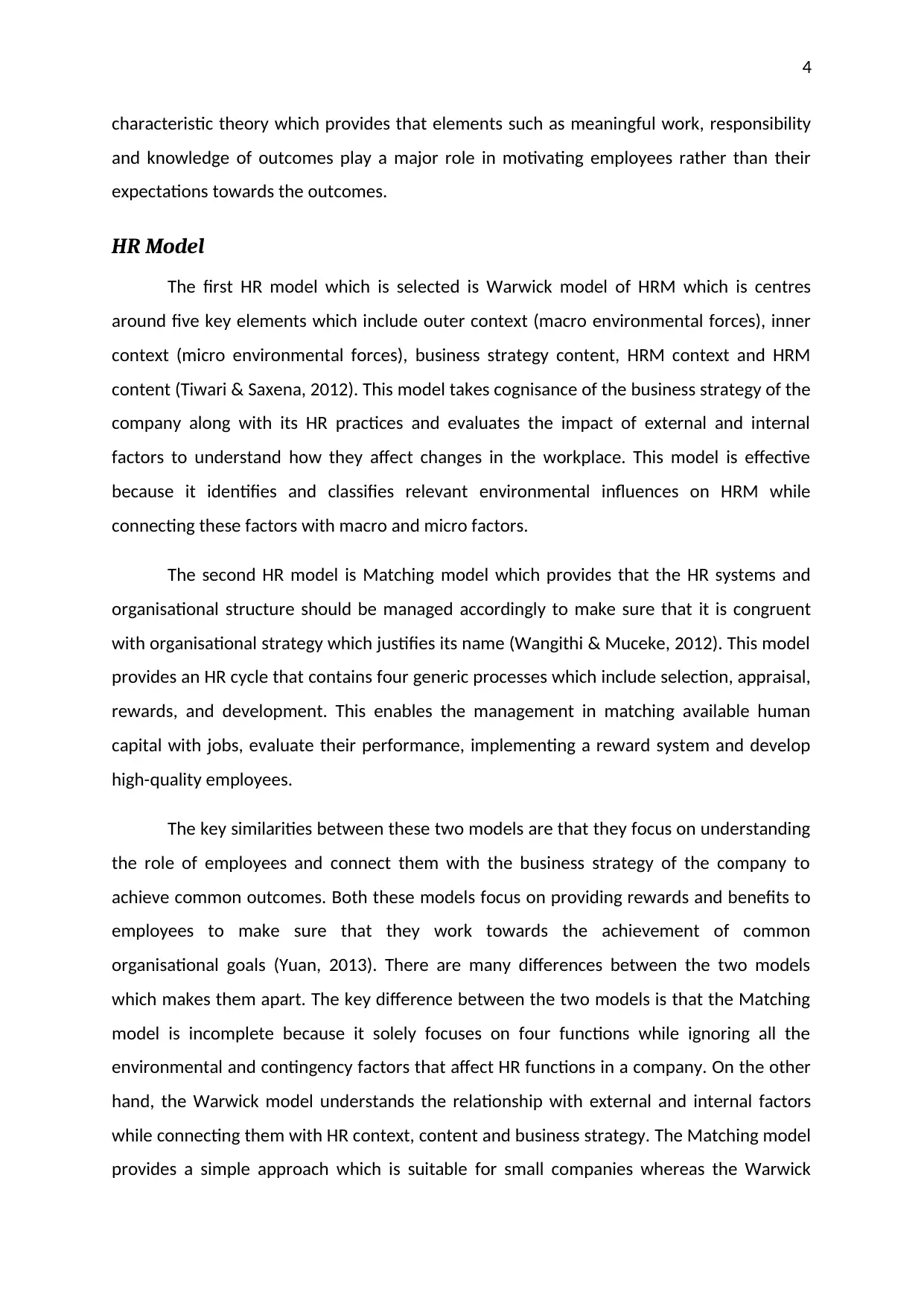
4
characteristic theory which provides that elements such as meaningful work, responsibility
and knowledge of outcomes play a major role in motivating employees rather than their
expectations towards the outcomes.
HR Model
The first HR model which is selected is Warwick model of HRM which is centres
around five key elements which include outer context (macro environmental forces), inner
context (micro environmental forces), business strategy content, HRM context and HRM
content (Tiwari & Saxena, 2012). This model takes cognisance of the business strategy of the
company along with its HR practices and evaluates the impact of external and internal
factors to understand how they affect changes in the workplace. This model is effective
because it identifies and classifies relevant environmental influences on HRM while
connecting these factors with macro and micro factors.
The second HR model is Matching model which provides that the HR systems and
organisational structure should be managed accordingly to make sure that it is congruent
with organisational strategy which justifies its name (Wangithi & Muceke, 2012). This model
provides an HR cycle that contains four generic processes which include selection, appraisal,
rewards, and development. This enables the management in matching available human
capital with jobs, evaluate their performance, implementing a reward system and develop
high-quality employees.
The key similarities between these two models are that they focus on understanding
the role of employees and connect them with the business strategy of the company to
achieve common outcomes. Both these models focus on providing rewards and benefits to
employees to make sure that they work towards the achievement of common
organisational goals (Yuan, 2013). There are many differences between the two models
which makes them apart. The key difference between the two models is that the Matching
model is incomplete because it solely focuses on four functions while ignoring all the
environmental and contingency factors that affect HR functions in a company. On the other
hand, the Warwick model understands the relationship with external and internal factors
while connecting them with HR context, content and business strategy. The Matching model
provides a simple approach which is suitable for small companies whereas the Warwick
characteristic theory which provides that elements such as meaningful work, responsibility
and knowledge of outcomes play a major role in motivating employees rather than their
expectations towards the outcomes.
HR Model
The first HR model which is selected is Warwick model of HRM which is centres
around five key elements which include outer context (macro environmental forces), inner
context (micro environmental forces), business strategy content, HRM context and HRM
content (Tiwari & Saxena, 2012). This model takes cognisance of the business strategy of the
company along with its HR practices and evaluates the impact of external and internal
factors to understand how they affect changes in the workplace. This model is effective
because it identifies and classifies relevant environmental influences on HRM while
connecting these factors with macro and micro factors.
The second HR model is Matching model which provides that the HR systems and
organisational structure should be managed accordingly to make sure that it is congruent
with organisational strategy which justifies its name (Wangithi & Muceke, 2012). This model
provides an HR cycle that contains four generic processes which include selection, appraisal,
rewards, and development. This enables the management in matching available human
capital with jobs, evaluate their performance, implementing a reward system and develop
high-quality employees.
The key similarities between these two models are that they focus on understanding
the role of employees and connect them with the business strategy of the company to
achieve common outcomes. Both these models focus on providing rewards and benefits to
employees to make sure that they work towards the achievement of common
organisational goals (Yuan, 2013). There are many differences between the two models
which makes them apart. The key difference between the two models is that the Matching
model is incomplete because it solely focuses on four functions while ignoring all the
environmental and contingency factors that affect HR functions in a company. On the other
hand, the Warwick model understands the relationship with external and internal factors
while connecting them with HR context, content and business strategy. The Matching model
provides a simple approach which is suitable for small companies whereas the Warwick
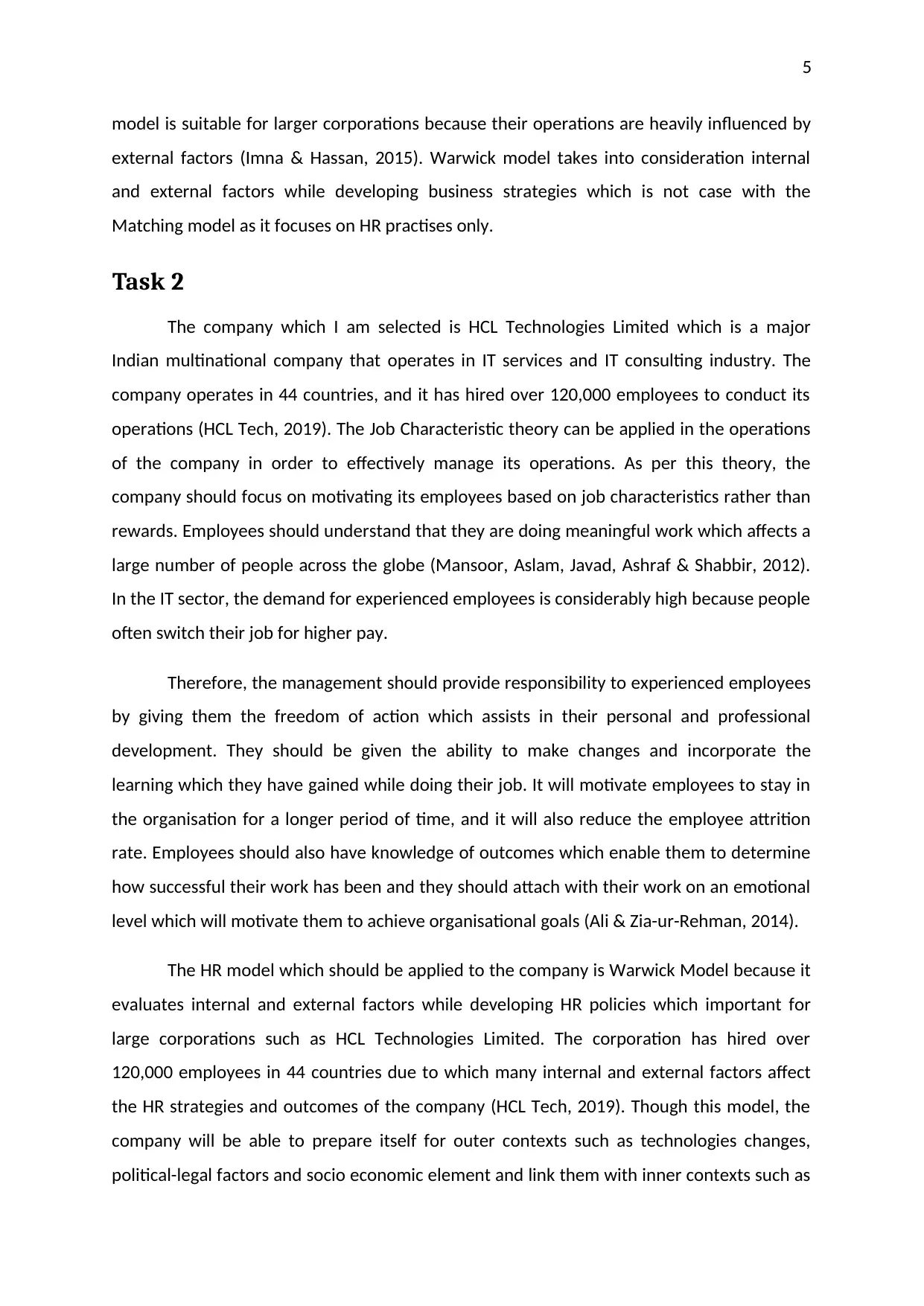
5
model is suitable for larger corporations because their operations are heavily influenced by
external factors (Imna & Hassan, 2015). Warwick model takes into consideration internal
and external factors while developing business strategies which is not case with the
Matching model as it focuses on HR practises only.
Task 2
The company which I am selected is HCL Technologies Limited which is a major
Indian multinational company that operates in IT services and IT consulting industry. The
company operates in 44 countries, and it has hired over 120,000 employees to conduct its
operations (HCL Tech, 2019). The Job Characteristic theory can be applied in the operations
of the company in order to effectively manage its operations. As per this theory, the
company should focus on motivating its employees based on job characteristics rather than
rewards. Employees should understand that they are doing meaningful work which affects a
large number of people across the globe (Mansoor, Aslam, Javad, Ashraf & Shabbir, 2012).
In the IT sector, the demand for experienced employees is considerably high because people
often switch their job for higher pay.
Therefore, the management should provide responsibility to experienced employees
by giving them the freedom of action which assists in their personal and professional
development. They should be given the ability to make changes and incorporate the
learning which they have gained while doing their job. It will motivate employees to stay in
the organisation for a longer period of time, and it will also reduce the employee attrition
rate. Employees should also have knowledge of outcomes which enable them to determine
how successful their work has been and they should attach with their work on an emotional
level which will motivate them to achieve organisational goals (Ali & Zia-ur-Rehman, 2014).
The HR model which should be applied to the company is Warwick Model because it
evaluates internal and external factors while developing HR policies which important for
large corporations such as HCL Technologies Limited. The corporation has hired over
120,000 employees in 44 countries due to which many internal and external factors affect
the HR strategies and outcomes of the company (HCL Tech, 2019). Though this model, the
company will be able to prepare itself for outer contexts such as technologies changes,
political-legal factors and socio economic element and link them with inner contexts such as
model is suitable for larger corporations because their operations are heavily influenced by
external factors (Imna & Hassan, 2015). Warwick model takes into consideration internal
and external factors while developing business strategies which is not case with the
Matching model as it focuses on HR practises only.
Task 2
The company which I am selected is HCL Technologies Limited which is a major
Indian multinational company that operates in IT services and IT consulting industry. The
company operates in 44 countries, and it has hired over 120,000 employees to conduct its
operations (HCL Tech, 2019). The Job Characteristic theory can be applied in the operations
of the company in order to effectively manage its operations. As per this theory, the
company should focus on motivating its employees based on job characteristics rather than
rewards. Employees should understand that they are doing meaningful work which affects a
large number of people across the globe (Mansoor, Aslam, Javad, Ashraf & Shabbir, 2012).
In the IT sector, the demand for experienced employees is considerably high because people
often switch their job for higher pay.
Therefore, the management should provide responsibility to experienced employees
by giving them the freedom of action which assists in their personal and professional
development. They should be given the ability to make changes and incorporate the
learning which they have gained while doing their job. It will motivate employees to stay in
the organisation for a longer period of time, and it will also reduce the employee attrition
rate. Employees should also have knowledge of outcomes which enable them to determine
how successful their work has been and they should attach with their work on an emotional
level which will motivate them to achieve organisational goals (Ali & Zia-ur-Rehman, 2014).
The HR model which should be applied to the company is Warwick Model because it
evaluates internal and external factors while developing HR policies which important for
large corporations such as HCL Technologies Limited. The corporation has hired over
120,000 employees in 44 countries due to which many internal and external factors affect
the HR strategies and outcomes of the company (HCL Tech, 2019). Though this model, the
company will be able to prepare itself for outer contexts such as technologies changes,
political-legal factors and socio economic element and link them with inner contexts such as
⊘ This is a preview!⊘
Do you want full access?
Subscribe today to unlock all pages.

Trusted by 1+ million students worldwide
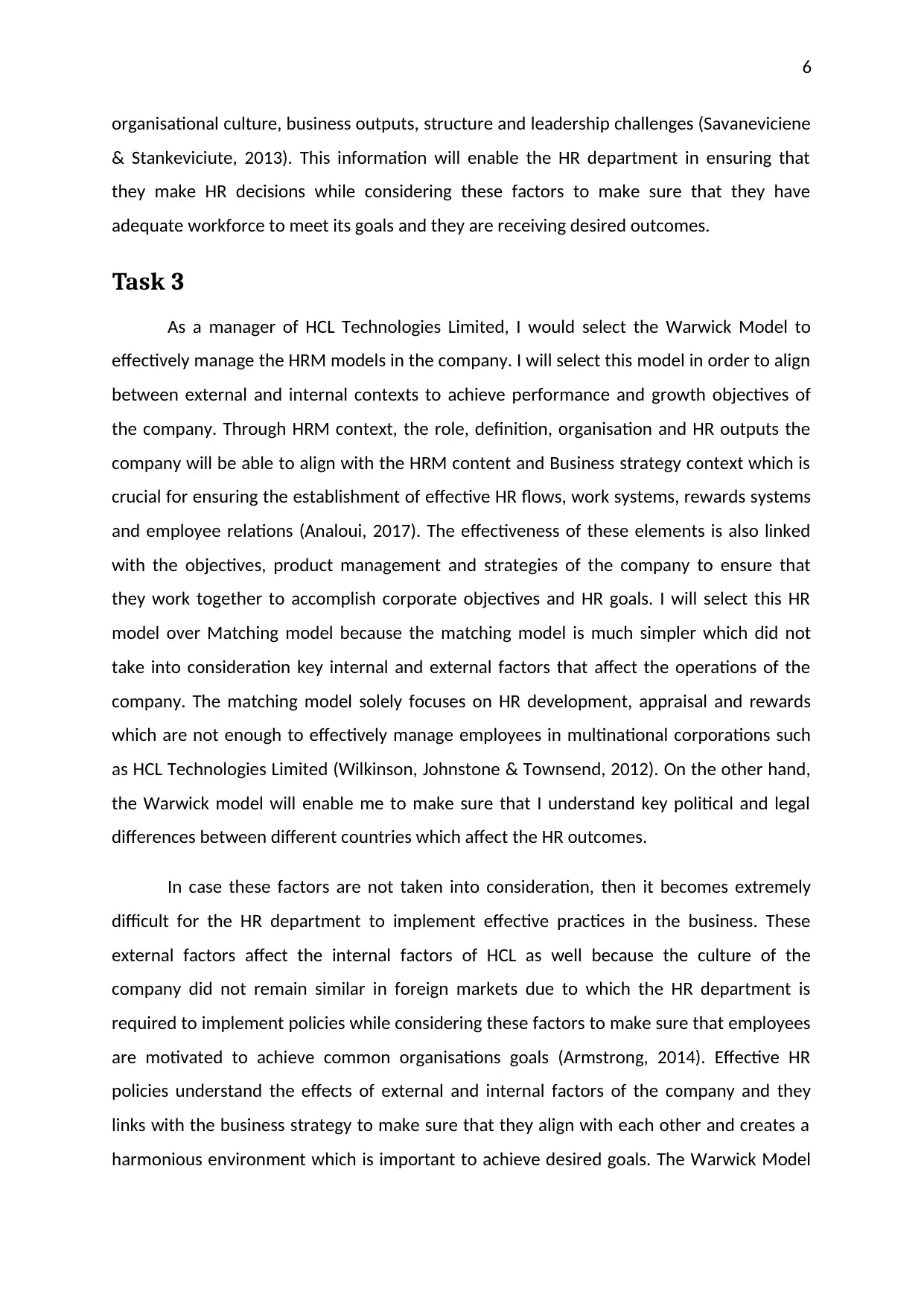
6
organisational culture, business outputs, structure and leadership challenges (Savaneviciene
& Stankeviciute, 2013). This information will enable the HR department in ensuring that
they make HR decisions while considering these factors to make sure that they have
adequate workforce to meet its goals and they are receiving desired outcomes.
Task 3
As a manager of HCL Technologies Limited, I would select the Warwick Model to
effectively manage the HRM models in the company. I will select this model in order to align
between external and internal contexts to achieve performance and growth objectives of
the company. Through HRM context, the role, definition, organisation and HR outputs the
company will be able to align with the HRM content and Business strategy context which is
crucial for ensuring the establishment of effective HR flows, work systems, rewards systems
and employee relations (Analoui, 2017). The effectiveness of these elements is also linked
with the objectives, product management and strategies of the company to ensure that
they work together to accomplish corporate objectives and HR goals. I will select this HR
model over Matching model because the matching model is much simpler which did not
take into consideration key internal and external factors that affect the operations of the
company. The matching model solely focuses on HR development, appraisal and rewards
which are not enough to effectively manage employees in multinational corporations such
as HCL Technologies Limited (Wilkinson, Johnstone & Townsend, 2012). On the other hand,
the Warwick model will enable me to make sure that I understand key political and legal
differences between different countries which affect the HR outcomes.
In case these factors are not taken into consideration, then it becomes extremely
difficult for the HR department to implement effective practices in the business. These
external factors affect the internal factors of HCL as well because the culture of the
company did not remain similar in foreign markets due to which the HR department is
required to implement policies while considering these factors to make sure that employees
are motivated to achieve common organisations goals (Armstrong, 2014). Effective HR
policies understand the effects of external and internal factors of the company and they
links with the business strategy to make sure that they align with each other and creates a
harmonious environment which is important to achieve desired goals. The Warwick Model
organisational culture, business outputs, structure and leadership challenges (Savaneviciene
& Stankeviciute, 2013). This information will enable the HR department in ensuring that
they make HR decisions while considering these factors to make sure that they have
adequate workforce to meet its goals and they are receiving desired outcomes.
Task 3
As a manager of HCL Technologies Limited, I would select the Warwick Model to
effectively manage the HRM models in the company. I will select this model in order to align
between external and internal contexts to achieve performance and growth objectives of
the company. Through HRM context, the role, definition, organisation and HR outputs the
company will be able to align with the HRM content and Business strategy context which is
crucial for ensuring the establishment of effective HR flows, work systems, rewards systems
and employee relations (Analoui, 2017). The effectiveness of these elements is also linked
with the objectives, product management and strategies of the company to ensure that
they work together to accomplish corporate objectives and HR goals. I will select this HR
model over Matching model because the matching model is much simpler which did not
take into consideration key internal and external factors that affect the operations of the
company. The matching model solely focuses on HR development, appraisal and rewards
which are not enough to effectively manage employees in multinational corporations such
as HCL Technologies Limited (Wilkinson, Johnstone & Townsend, 2012). On the other hand,
the Warwick model will enable me to make sure that I understand key political and legal
differences between different countries which affect the HR outcomes.
In case these factors are not taken into consideration, then it becomes extremely
difficult for the HR department to implement effective practices in the business. These
external factors affect the internal factors of HCL as well because the culture of the
company did not remain similar in foreign markets due to which the HR department is
required to implement policies while considering these factors to make sure that employees
are motivated to achieve common organisations goals (Armstrong, 2014). Effective HR
policies understand the effects of external and internal factors of the company and they
links with the business strategy to make sure that they align with each other and creates a
harmonious environment which is important to achieve desired goals. The Warwick Model
Paraphrase This Document
Need a fresh take? Get an instant paraphrase of this document with our AI Paraphraser
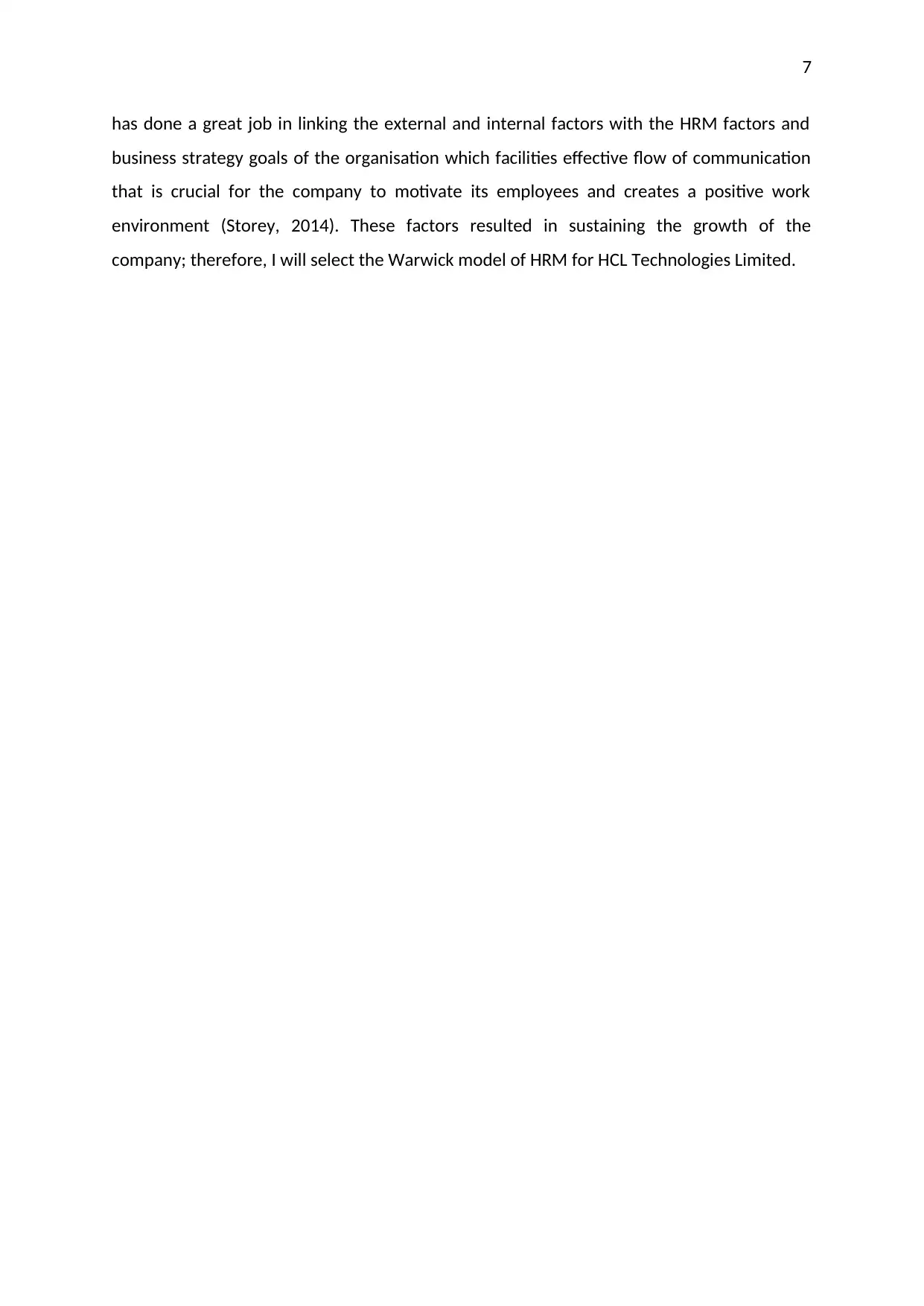
7
has done a great job in linking the external and internal factors with the HRM factors and
business strategy goals of the organisation which facilities effective flow of communication
that is crucial for the company to motivate its employees and creates a positive work
environment (Storey, 2014). These factors resulted in sustaining the growth of the
company; therefore, I will select the Warwick model of HRM for HCL Technologies Limited.
has done a great job in linking the external and internal factors with the HRM factors and
business strategy goals of the organisation which facilities effective flow of communication
that is crucial for the company to motivate its employees and creates a positive work
environment (Storey, 2014). These factors resulted in sustaining the growth of the
company; therefore, I will select the Warwick model of HRM for HCL Technologies Limited.

8
Conclusion
In conclusion, Expectancy theory and Job Characteristic theory enables the HR
department in implementing effective business policies to motivate employees. Similarly,
the Warwick model and Matching model of HRM enable companies to implement policies
which are focused on a wider range of factors that affects the outcomes of the organisation.
The example of HCL Technologies Limited is evaluated in this essay to apply Job
Characteristic theory and Warwick model on the organisation. As a manager, I would select
the Warwick model for HCL technologies because it evaluates internal as well as external
factors and links them together to achieve desired HR outcomes which will sustain the
growth of the company.
Conclusion
In conclusion, Expectancy theory and Job Characteristic theory enables the HR
department in implementing effective business policies to motivate employees. Similarly,
the Warwick model and Matching model of HRM enable companies to implement policies
which are focused on a wider range of factors that affects the outcomes of the organisation.
The example of HCL Technologies Limited is evaluated in this essay to apply Job
Characteristic theory and Warwick model on the organisation. As a manager, I would select
the Warwick model for HCL technologies because it evaluates internal as well as external
factors and links them together to achieve desired HR outcomes which will sustain the
growth of the company.
⊘ This is a preview!⊘
Do you want full access?
Subscribe today to unlock all pages.

Trusted by 1+ million students worldwide
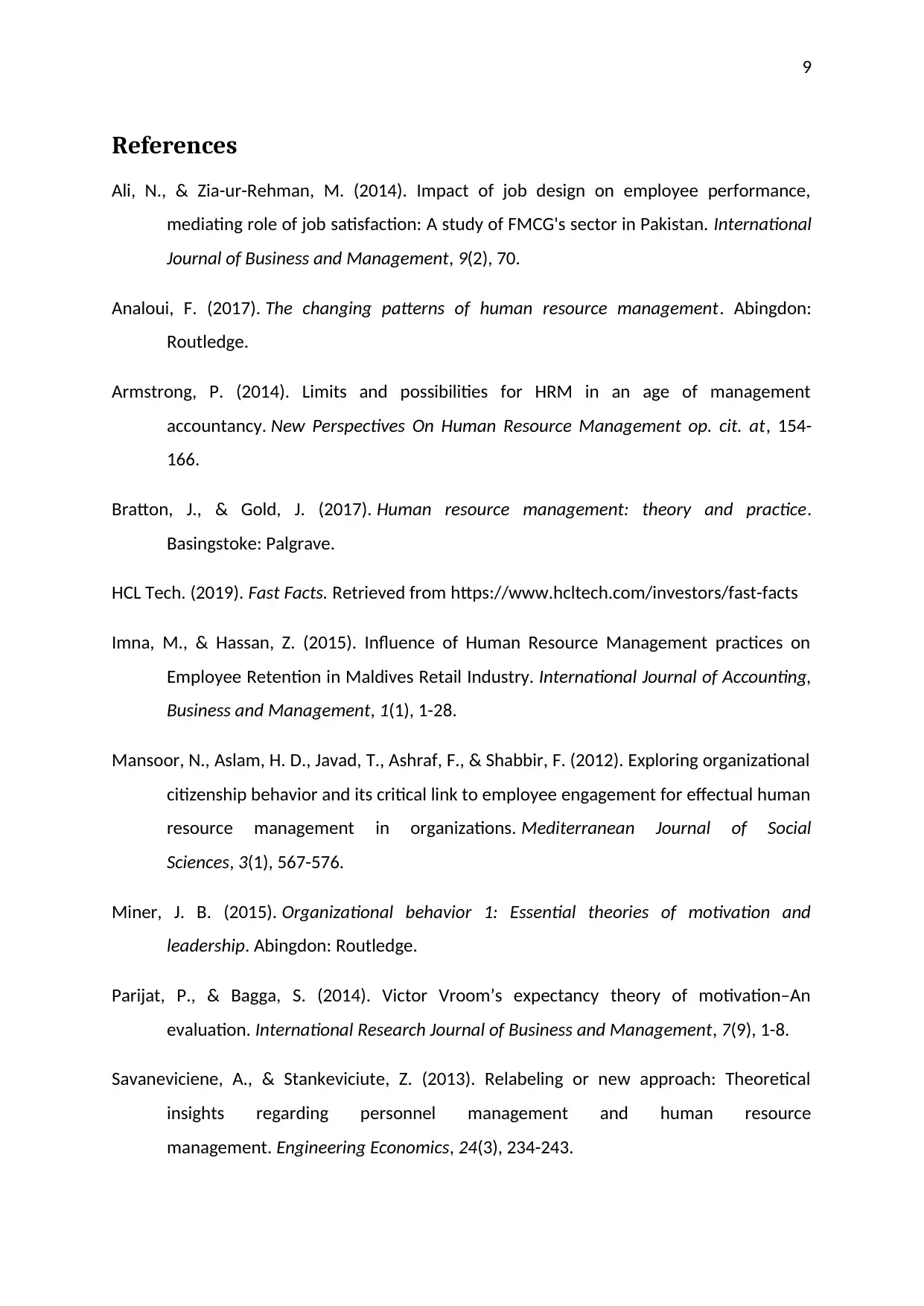
9
References
Ali, N., & Zia-ur-Rehman, M. (2014). Impact of job design on employee performance,
mediating role of job satisfaction: A study of FMCG's sector in Pakistan. International
Journal of Business and Management, 9(2), 70.
Analoui, F. (2017). The changing patterns of human resource management. Abingdon:
Routledge.
Armstrong, P. (2014). Limits and possibilities for HRM in an age of management
accountancy. New Perspectives On Human Resource Management op. cit. at, 154-
166.
Bratton, J., & Gold, J. (2017). Human resource management: theory and practice.
Basingstoke: Palgrave.
HCL Tech. (2019). Fast Facts. Retrieved from https://www.hcltech.com/investors/fast-facts
Imna, M., & Hassan, Z. (2015). Influence of Human Resource Management practices on
Employee Retention in Maldives Retail Industry. International Journal of Accounting,
Business and Management, 1(1), 1-28.
Mansoor, N., Aslam, H. D., Javad, T., Ashraf, F., & Shabbir, F. (2012). Exploring organizational
citizenship behavior and its critical link to employee engagement for effectual human
resource management in organizations. Mediterranean Journal of Social
Sciences, 3(1), 567-576.
Miner, J. B. (2015). Organizational behavior 1: Essential theories of motivation and
leadership. Abingdon: Routledge.
Parijat, P., & Bagga, S. (2014). Victor Vroom’s expectancy theory of motivation–An
evaluation. International Research Journal of Business and Management, 7(9), 1-8.
Savaneviciene, A., & Stankeviciute, Z. (2013). Relabeling or new approach: Theoretical
insights regarding personnel management and human resource
management. Engineering Economics, 24(3), 234-243.
References
Ali, N., & Zia-ur-Rehman, M. (2014). Impact of job design on employee performance,
mediating role of job satisfaction: A study of FMCG's sector in Pakistan. International
Journal of Business and Management, 9(2), 70.
Analoui, F. (2017). The changing patterns of human resource management. Abingdon:
Routledge.
Armstrong, P. (2014). Limits and possibilities for HRM in an age of management
accountancy. New Perspectives On Human Resource Management op. cit. at, 154-
166.
Bratton, J., & Gold, J. (2017). Human resource management: theory and practice.
Basingstoke: Palgrave.
HCL Tech. (2019). Fast Facts. Retrieved from https://www.hcltech.com/investors/fast-facts
Imna, M., & Hassan, Z. (2015). Influence of Human Resource Management practices on
Employee Retention in Maldives Retail Industry. International Journal of Accounting,
Business and Management, 1(1), 1-28.
Mansoor, N., Aslam, H. D., Javad, T., Ashraf, F., & Shabbir, F. (2012). Exploring organizational
citizenship behavior and its critical link to employee engagement for effectual human
resource management in organizations. Mediterranean Journal of Social
Sciences, 3(1), 567-576.
Miner, J. B. (2015). Organizational behavior 1: Essential theories of motivation and
leadership. Abingdon: Routledge.
Parijat, P., & Bagga, S. (2014). Victor Vroom’s expectancy theory of motivation–An
evaluation. International Research Journal of Business and Management, 7(9), 1-8.
Savaneviciene, A., & Stankeviciute, Z. (2013). Relabeling or new approach: Theoretical
insights regarding personnel management and human resource
management. Engineering Economics, 24(3), 234-243.
Paraphrase This Document
Need a fresh take? Get an instant paraphrase of this document with our AI Paraphraser
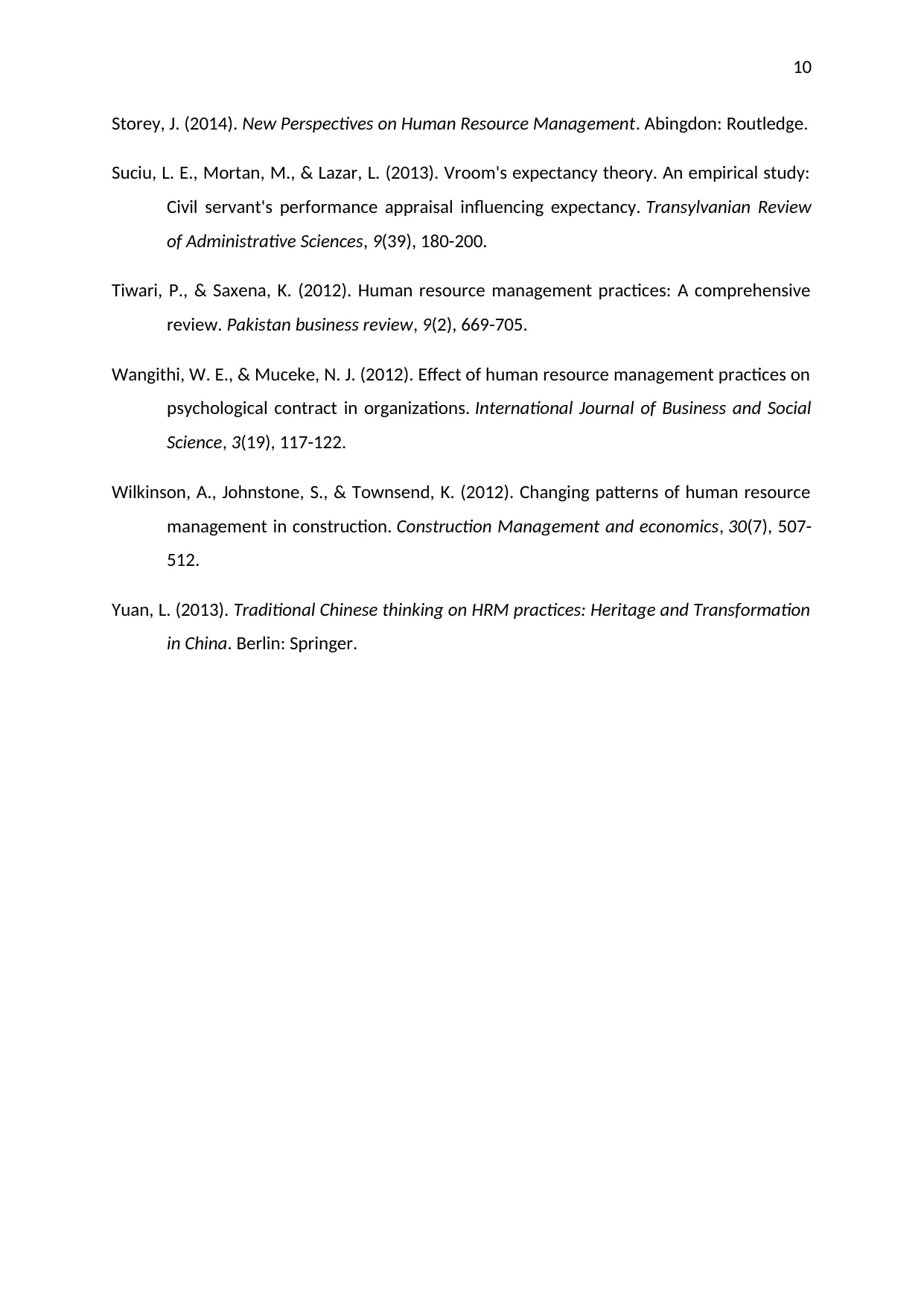
10
Storey, J. (2014). New Perspectives on Human Resource Management. Abingdon: Routledge.
Suciu, L. E., Mortan, M., & Lazar, L. (2013). Vroom's expectancy theory. An empirical study:
Civil servant's performance appraisal influencing expectancy. Transylvanian Review
of Administrative Sciences, 9(39), 180-200.
Tiwari, P., & Saxena, K. (2012). Human resource management practices: A comprehensive
review. Pakistan business review, 9(2), 669-705.
Wangithi, W. E., & Muceke, N. J. (2012). Effect of human resource management practices on
psychological contract in organizations. International Journal of Business and Social
Science, 3(19), 117-122.
Wilkinson, A., Johnstone, S., & Townsend, K. (2012). Changing patterns of human resource
management in construction. Construction Management and economics, 30(7), 507-
512.
Yuan, L. (2013). Traditional Chinese thinking on HRM practices: Heritage and Transformation
in China. Berlin: Springer.
Storey, J. (2014). New Perspectives on Human Resource Management. Abingdon: Routledge.
Suciu, L. E., Mortan, M., & Lazar, L. (2013). Vroom's expectancy theory. An empirical study:
Civil servant's performance appraisal influencing expectancy. Transylvanian Review
of Administrative Sciences, 9(39), 180-200.
Tiwari, P., & Saxena, K. (2012). Human resource management practices: A comprehensive
review. Pakistan business review, 9(2), 669-705.
Wangithi, W. E., & Muceke, N. J. (2012). Effect of human resource management practices on
psychological contract in organizations. International Journal of Business and Social
Science, 3(19), 117-122.
Wilkinson, A., Johnstone, S., & Townsend, K. (2012). Changing patterns of human resource
management in construction. Construction Management and economics, 30(7), 507-
512.
Yuan, L. (2013). Traditional Chinese thinking on HRM practices: Heritage and Transformation
in China. Berlin: Springer.
1 out of 11
Related Documents
Your All-in-One AI-Powered Toolkit for Academic Success.
+13062052269
info@desklib.com
Available 24*7 on WhatsApp / Email
![[object Object]](/_next/static/media/star-bottom.7253800d.svg)
Unlock your academic potential
Copyright © 2020–2025 A2Z Services. All Rights Reserved. Developed and managed by ZUCOL.





